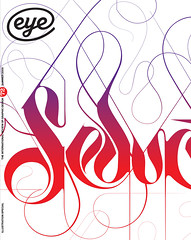Summer 2009
Editorial Eye 72
John L. Walters
Build
Universal Everything
Christoph Niemann
Marian Bantjes
James Joyce
Brian Knight
Last summer we tackled the canon of graphic design history in a special issue; this time we address the even more knotty subject of illustration. Not by establishing any kind of canon, but by looking at illustration at the myriad points where it touches and intersects with graphic design, designers and design thinking.
The visual material we show in ‘The graphic designer as illustrator’ demonstrates that we are living through an abundant time for made images. The factor that makes designers such as Michael C. Place (Build) and Matt Pyke (Universal Everything) genuinely popular figures is their talent for image-making, a delight in the visual that both meets and transcends the strictures of most design-illustration briefs. In his essay ‘Schism and reunification’ Adrian Shaughnessy contrasts this trend with the Platonic idea of ‘pure’ graphic design – free of illustration or photography – and compares it to earlier eras when it was taken for granted that designers painted and drew as part of their practice.
There’s an ever-present temptation to describe the rise of designer-illustrators and their unapologetic mark-making as ‘nostalgia de la boue’, a punkish rejection of technological sophistication. Yet the reverse is more often true – many of the most prolific practitioners are ‘digital natives’ in that they cannot recall a time before Macintosh and Adobe. For such artists, the technology is (literally) part of the picture, and much of the work featured in these pages would be unthinkable without their makers’ highly sophisticated, intuitive command of digital tools. The fluidity of contemporary work, for good or bad (see ‘Cult of the squiggly’) shows how seamlessly such technology has become integrated.
Marian Bantjes, whom we profile in Reputations, describes herself as a ‘lapsed graphic designer’, and also as ‘an illustrator of sorts and a typographer’. Bantjes, vividly describing her highly productive ‘mid-life crisis’, may be just outside the digital native demographic, but her witty and pleasingly obsessive work sets new standards for an original, entirely 21st-century approach to design authorship.
Christoph Niemann’s ‘Abstract City’ blog for the New York Times website redefines the conventions of writing and illustration to make a highly original framework for words and pictures. James Joyce and the MTV animators have similarly found new ways to redefine the made image within the technology of the moment. And though the meticulous ‘roughs’ and watercolours of Brian Knight make explicit the lost worlds of pre-Mac, hand-made artwork, his illustrative talents had their roots in the high-tech aviation of his time.
Little more than a year has passed since Eye became independent, though it seems like no time at all. Yet in that time we have made changes to improve the service we give our readers, such as print, paper, binding, a better mailing box for subscribers, and so on. We also have a new team dealing with your enquiries by phone and the ‘Eye shop’, a website where you can manage your subscription online and buy back issues. And we’ve had a redesign, as you can see. JLW
John L. Walters, editor of Eye, London
First published in Eye no. 72 vol. 18 2009
Eye is the world’s most beautiful and collectable graphic design journal, published quarterly for professional designers, students and anyone interested in critical, informed writing about graphic design and visual culture. It is available from all good design bookshops and online at the Eye shop, where you can buy subscriptions and single issues.

